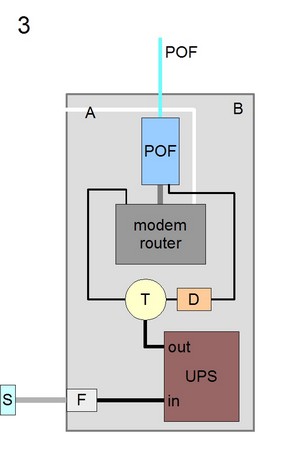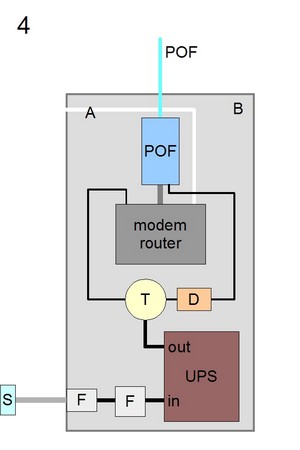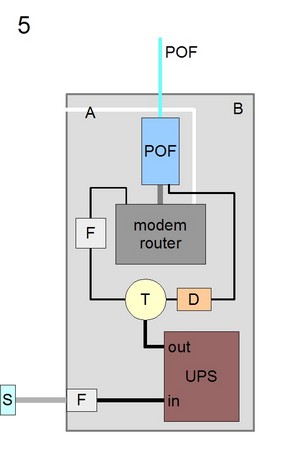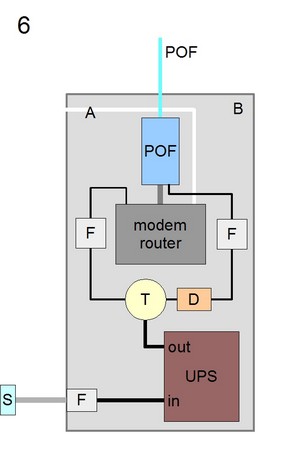Filters for AC power
Using AC filters for stopping the EM noise created in the mains by the ADSL
In our search for the reduction of all EMF in our home office we have done many things regarding the ADSL system.
In 2013 we discovered the Plastic Optical Fiber system (POF) and developed our first "ADSL POF box", which contains an ADSL modem-router and a number of POF Ethernet converters to connect it to one or more computers in the office. The optical Ethernet connection is very good because it detaches electrically the ADSL device from the computers, and because the cables have really zero EM emissions.
Then we started noticing the EMF radiated by the ADSL modem-router and by the ADSL wire. After many attempts we finally moved the ADSL box and the wire away, as far as possible. This solved the problem of the radiated EMF.
Then we started noticing that there was still some EMF in our workplace when the ADSL was turned on, and only when the ADSL was turned on.
We did many tests to establish exactly the source of this EM radiation and we concluded that this radiation was coming from the electric wires of the mains, which are embedded in the walls, and from the extension cords that are outside the walls.
The conclusion is that an ADSL device creates electromagnetic noise into the mains to which it is attached. This is another problem and it is difficult to solve because the mains cables are fixed in the walls or in the ceiling, or under the floor.
This problem is especially serious if the ADSL device is attached to the same branch of the mains that gives power to the office room, but it can happen also if the ADSL device and the office are on different branches that depart from the central switch box.
The problem of the EM noise injected by the ADSL device into the mains is a case of what is commonly called "dirty electricity". Usually "dirty electricity" is caused by the internal power supplies of computers and other devices, however in our case the dirty electricity was due mostly to the ADSL modem-router, we didn't have problems due to the computers alone.
So we started to try to stop the EM noise from entering the mains cables at the source of the noise, which is the ADSL system. We tried many different systems, with some AC filters, and also a UPS (Uninterrupted Power Supply). This search is still going on, however we have obtained some positive results. Here are the most important steps of the research done so far.
Initial systemOur initial ADSL box contained the ADSL modem router connected to the POF Ethernet converter by means of a short Cat5 cable. The modem-router was powered by 12 V AC coming directly from a transformer, and the POF converter was powered by 5 V DC, coming from a suitable circuit powered by another output of the same transformer. The box had a small AC filter embedded in the AC connector. In the drawing A is the unshielded telephone wire, B is the steel box, S is the wall socket, T is the transformer. |

|
Step 2Since the EM noise entered into the mains through the wall socket, the first solution that we could think of was to insert an AC filter between the AC connector of the ADSL box and the wall socket. This solution was almost useless because the filter wasn't well grounded. However the ADSL box is made of galvanized steel and it is grounded, so we can put the AC filter inside the box, attached to the floor of the box or to a inner wall of the box, so the filter is also grounded. We did this and we noticed some reduction of the EMF, but it wasn't enough yet. |

|
Step 3We tried to put a UPS (Uninterrupted Power Supply) between the device and the mains so we could try the system while it was powered by the UPS, with the wall plug detached. This confirmed that the EM noise was injected into the mains. When the wall plug was inserted the UPS had a small filtering effect but it wasn't enough yet. |

|
Step 4Then we also tried to add a filter on the UPS input, to filter the noise that was going into the mains, but of course this wasn't enough, as this system is just the same as system 2 with the addition of the UPS. |

|
Step 5We realized that the EM noise generated by the ADSL modem router was passing along the 12 V AC wire to the transformer. The transformer is built for changing the input voltage, which is 230 V AC, to an output voltage of 12 V AC. But transformers are passive devices, and they are bidirectional, so if there is a voltage wave on the transformer's output, then the transformer creates a larger voltage wave on its input, and the ratio of this voltage over the noise coming from the device is approximately 230/12 = 19. This means that the transformer amplifies the noise, at least in terms of voltage. These filters can be used also on a 12 V AC line, so we put one filter on the line from the transformer to the device, always keeping it grounded inside the box. This system showed a positive effect greater than the previous one. |

|
Step 6After some time we noticed that there was still some EMF in the room when the ADSL was turned on. So we saw that there was another path for the EM noise from the modem-router to the socket. The POF ethernet converter is attached to a RJ45 port of the router by means of a short Cat5 cable. This creates a path for the EM noise of the ADSL that passes also to the circuit of the POF converter. Since the POF converter is powered by a 5 V DC line coming from the same transformer, there is another path for the noise. The 5 V DC is obtained by means of a small circuit consisting of a rectifier, a few capacitors, and a 5V regulator, but evidently the noise travels back along this small circuit and reaches the transformer, where it is also amplified by a factor 230/5 = 46. So we inserted an AC filter on the 5V DC line too. AC filters like these can also work on DC, the DC voltage passes through the filter unchanged, while the EM noise is reduced. This system has shown to be noticeably better than the previous one. |

|
About the ADSL device
The original ADSL modem-router that we use is produced by D-Link and has just a 12 V AC transformer for its power input, without any filter. This is a big mistake by the D-Link company, who haven't considered that such a transformer actually amplifies the EM noise coming from the device and passes it to the mains. But of course this problem is secondary with respect to the terrible EMF radiated by the ADSL device directly all around, which caused us much more severe symptoms and required a whole shielding box and also moving this box away from the work room.
Other similar systems
The facts showed in this page can also be applied to other similar systems. Instead of the ADSL there could be a cable modem, instead of the POF Ethernet there could be another type of optical link. Of course if there is an electric cable from the router to the computer this cable will conduct the EM noise to the computer room, and it will also radiate it all around so it is always better to use an optical device and cable.